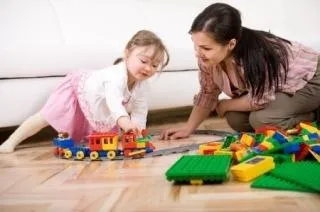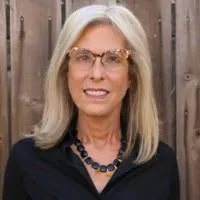The Social Communication Blog
By Linda Boverman

NO CELL PHONES. NO GAMES. NO ELECTRONICS — JUST 20 MINUTES A DAY– PART 2: A STORY
THE 20 MINUTE SOLUTION: PART 2

I was sitting on my brother’s porch across from my two and a half-year-old grandnephew. Between us was the same little Brio wooden train set my son had played with when he was two and a half. My grandnephew was pushing the train along the small track, under a bridge, through a crossing gate. He couldn’t get it all the way around by himself, so I was pushing it back to him.
I don’t remember exactly how I got there with my grandnephew. He may have asked me to play with him. He may have asked a few times before I wised up.
I do remember I stimulated his language. Stimulating language is almost part of my DNA. It’s my profession. I can’t help myself. It’s also a way I connect to a child.
I said things like, “Ok, I’ll push it… It’s your turn… Oops, I made it fall off the track, there…. Should I put the engine in the front or the back?… Here it is…. You’re turn… You do it.”
He asked me again and again to push it to him in his not always small but always eager voice. I sat there for maybe 40 minutes.
“Here goes … oh through the tunnel… where could it be?…oh, there it is… coming out the other end.… “
Although I still cherish the time I spent with my little guy, sometimes I was a little bored. No, sometimes I was a lot bored. PUSHING and PUSHING and PUSHING–AGAIN and AGAIN and AGAIN.
Part of me would have preferred to have been talking with the adults. I had a glass of wine and was fed appetizers by passer-bys, which helped. Because I value playing with children, with or without my treats, I knew to value this special time. Still, I had no idea what was really happening during those moments until about a week later at a family campout.

There were maybe 18 of us sitting around a campfire, adults and children. My grandnephew was on his mother’s lap. He crawled off and darted to me, half-way around the fire. He almost crashed into me. I grabbed him, held him, and gave him “kissies”. He giggled and squealed, and I let him go. He darted back to his mother. Then he turned around and did it all over again. He did it at least a dozen times, likely more. I loved it. My adorable little grandnephew, was engaging me, trusting me, and connecting with me in his own inimitable way.
At the time, it crossed my mind that this little game came out of our time playing trains. Me just sitting there, my full attention on him and the game, pushing the small pieces of wood to him (and, of course, smiling at him) creating an opportunity for connection. I certainly felt like we were bonding. But I still didn’t truly understand what that time meant until about six months later when I believe the total reveal occurred.
I was sitting on the floor in his living room, playing with him–I can’t remember with what. We didn’t have very much time, not like the time we had on my brother’s deck or at the campout. But I reminded him about our time playing trains. “Remember when we played with the train at Grandpa’s?” I asked, more out of curiosity as to whether he could remember those moments. He gave me a look I couldn’t discern then his eyes darted to the side. I followed his gaze and there it was. The Brio train set stored in a clear plastic container.
That’s when I really got it. I believe those few minutes on the deck with the Brio set and my grandnephew created our game around the fire, created his running up to me with open arms when he saw me during this trip to his house, and possibly created a life-long buddy. I expect him to forget the specifics of those few minutes–I hope he doesn’t forget the feelings.
I won’t. Both of us relishing and growing, experiencing and showing delight in the moment. I believe, in his little guy way, my grandnephew felt the same inner joy as I did. In my mind, there is nothing better. And it all occurred because I took a few minutes to push a few pieces of wood around a track as if there was nothing more important.
“How we communicate affects our joy of being alive.” – Lindaake 30 minutes to edit your post.

Copyright 2023 . All rights reserved
lindaboverman@gmail.com
(213) 804-7750

